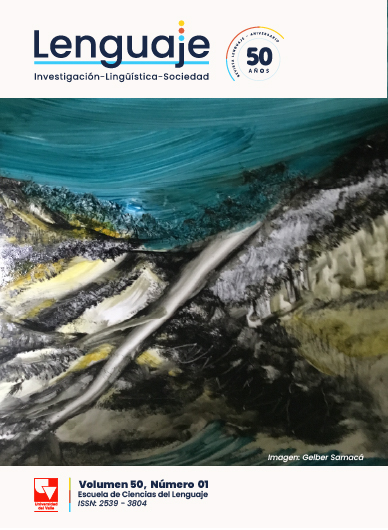Fomentando el involucramiento en el aprendizaje de lenguas a través de prácticas de alfabetización critica
Contenido principal del artículo
El estudio descrito en este artículo intenta determinar la relación existente entre el involucramiento en el aprendizaje de idiomas y la alfabetización crítica de 34 estudiantes de noveno grado de una escuela pública de Caquetá, Colombia. Se realizó una investigación acción participativa y se usaron los siguientes instrumentos de recolección de información: entrevistas grupales, cuestionarios y artefactos escolares. Las experiencias de los estudiantes en relación con temas sociales informaron la práctica de alfabetización crítica para proporcionar a los aprendices las herramientas necesarias para enfrentar los problemas que ocurren en su comunidad. Los resultados de esta investigación sugieren que la práctica de una alfabetización crítica compromete a los estudiantes en el proceso de aprendizaje desde unas dimensiones cognitivas, sociales y emocionales. Este enfoque crítico juega un papel crucial en activar la disposición de los estudiantes para enfrentar el aprendizaje de un idioma y contrarrestar las emergentes dificultades para aprender.
- alfabetización crítica
- aprendizaje de idiomas
- involucramiento en el aprendizaje de lenguas
- problemáticas sociales
Ahn, S.-Y. (2016). Exploring language awareness through students' engagement in language play. Language Awareness, 25(1-2), 40-54. https://doi.org/10.1080/09658416.2015.1122020.
Al Rifai, N. (2010). Attitude, motivation, and difficulties involved in learning the English language and factors that affect motivation in learning it. Procedia-Social and Behavioral Sciences, 2(2), 5216-5227. https://doi.org/10.1016/j.sbspro.2010.03.849.
Appleton, J.J., Christenson, S.L., Kim, D., & Reschly, A.L. (2006). Measuring cognitive and psychological engagement: Validation of the Student Engagement Instrument. Journal of School Psychology, 44(5), 427-445. https://doi.org/10.1016/j.jsp.2006.04.002.
Bacon, C.K. (2017) Multilanguage, Multipurpose: A Literature Review, Synthesis, and Framework for Critical Literacies in English Language Teaching. Journal of Literacy Research, 49(3), 424-453. https://doi.org/10.1177/1086296X17718324.
Barno, R. (2014). Critical Literacy for Transformation (Doctoral dissertation). Binghamton University, New York, United States of America.
Betts, J. (2012). Issues and Methods in the Measurement of Student Engagement: Advancing the Construct Through Statistical Modeling. In S.L. Christenson, A.L. Reschly & C. Wylie (Eds.), Handbook of Research on Student Engagement (pp. 783-803). https://doi.org/10.1007/978-1-4614-2018-7_38.
Cañas, C., & Ocampo, A.P. (October 18, 2013). Creating New Literacy Approaches in Our Classroom. ML2 – Second Language Literacies [Online]. https://ml2secondlanguageliteracies.wordpress.com/2013/10/18/creating-new-literacy-approaches-in-our-classroom/.
Comber, B. (2017). Literacy Geography and Pedagogy: Imagining Translocal Research Alliances for Educational Justice. Literacy Research: Theory, Method, and Practice, 66, 53-72. https://doi.org/10.1177/2381336917717479.
Contreras, J., & Chapetón, C. (2017). Transmorfing EFL Classroom and Promoting Students’ Empowerment: Collaborative Learning From a Dialogical Approach. PROFILE: Issues in Teachers’ Professional Development 19(2), 135-149. https://doi.org/10.15446/profile.v19n2.57811.
Creswell, J.W. (2014). Research Design: Qualitative, Quantitative and Mixed Methods Approaches (4th ed.). Sage.
Cruz, A. (2018). The Wisdom of Teachers’ Personal Theories: Creative ELT Practices From Colombian Rural Schools. PROFILE: Issues in Teachers’ Professional Development, 20(2), 65-78. https://doi.org/10.15446/profile.v20n2.67142.
Finlay, K.A. (2006). Quantifying School Engagement: Research Report [Online]. https://schoolengagement.org/wp-content/uploads/2021/02/QuantifyingSchoolEngagementResearchReport.pdf.
Fredricks, J.A., Blumenfeld, P.C., & Paris, A.H. (2004). School Engagement: Potential of the Concept, State of the Evidence. Review of Educational Research, 74(1), 59-109. https://doi.org/10.3102/00346543074001059.
Freire, P., & Macedo, D. (1987). Literacy: Reading the word & the world. Routledge.
Gillis, A., & Jackson, W. (2002). Research for Nurses: Methods and Interpretation. F.A. Davis Company.
Institución Educativa Juan Bautista la Salle. (2009). Proyecto Educativo Institucional [PEI].
Jordão, C., & Fogaça, F.C. (2012). Critical literacy in the English language classroom. DELTA: Documentação de Estudos em Lingüística Teórica e Aplicada, 28(1), 69-84. https://doi.org/10.1590/S0102-44502012000100004.
Kaminski, A. (2019). Young learners’ engagement with multimodal texts. ELT Journal, 73(2), 175-185. https://doi.org/10.1093/elt/ccy060.
Kemmis, S., & McTaggart, R. (2005). Participatory Action Research: Communicative Action and the Public Sphere. In N.K. Denzin & Y.S. Lincoln (Eds.), The Sage Handbook of Qualitative Research (3rd ed.) (pp. 559-603). SAGE Publications.
Kumaravadivelu, B. (2001). Toward a postmethod pedagogy. TESOL quarterly, 35(4), 537-560. http://www.bkumaravadivelu.com/articles%20in%20pdfs/2001%20Kumaravadivelu%20Postmethod%20Pedagogy.pdf.
Lally, C. (2002). Discrepancies in Teacher and Student Perceptions of French Language Performance. The French Review, 75(5), 926-941. https://www.jstor.org/stable/3133436.
Lankshear, C., & Knobel, M. (2009). More than words: Chris Searle’s approach to critical literacy as cultural action. Race & Class, 51(2), 59-78. https://doi.org/10.1177%2F0306396809345577.
Lewison, M., Flint, A., & Van Sluys, K. (2002). Taking on critical literacy: The journey of newcomers and novices. Language arts, 79(5), 382-392. https://www.jstor.org/stable/41483258.
Lewison, M., Leland, C., & Harste, J. (2007). Creating critical classrooms: K-8 Reading and Writing with an Edge. https://doi.org/10.4324/9780203826317.
Marks, H.M. (2000). Student Engagement in Instructional Activity: Patterns in the Elementary, Middle, and High School Years. American Educational Research Journal, 37(1), 153-184. https://doi.org/10.3102/00028312037001153.
Marshall, C., & Rossman, G.B. (2006). Designing Qualitative Research (4th ed.). Sage.
Mason, J. (2006). Mixing methods in a qualitatively driven way. Qualitative Research, 6(1), 9-25. https://doi.org/10.1177/1468794106058866.
Mathers, N., Fox, N., & Hunn, A. (2007). Surveys and Questionnaires. https://www.rds-yh.nihr.ac.uk/wp-content/uploads/2013/05/12_Surveys_and_Questionnaires_Revision_2009.pdf.
Miskovic, M., & Hoop, K. (2006). Action Research Meets Critical Pedagogy: Theory, Practice, and Reflection. Qualitative Inquiry, 12(2), 269-291. https://doi.org/10.1177/1077800405284367.
Norris, K., Lucas, L., & Prudhoe, C. (2012). Examining Critical Literacy: Preparing Preservice Teachers to Use Critical Literacy in the Early Childhood Classroom. Multicultural Education, 19(2), 59-62.
Philp, J., & Duchesne, S. (2016). Exploring Engagement in Tasks in the Language Classroom. Annual Review of Applied Linguistics, 36, 50-72. https://doi.org/10.1017/S0267190515000094.
Pineda, C., Bermúdez, J. Rubiano, Á., Pava, N., Suárez, R., & Cruz, F. (2014). Student engagement and academic performance in the Colombian university context. RELIEVE, 20(2), 1-19. https://doi.org/10.7203/relieve.20.2.4238.
Reschly, A.L., & Christenson, S.L. (2012). Jingle, Jangle, and Conceptual Haziness: Evolution and Future Directions of the Engagement Construct. In S.L. Christenson, A.L. Reschly & C. Wylie (Eds.), Handbook of Research on Student Engagement (pp. 3-19). http://dx.doi.org/10.1007/978-1-4614-2018-7_1.
Roca, J., & Murphy, L. (2001). Some Steps Towards a Socio-Cognitive Interpretation of Second Language Composition Processes. International Journal of English Studies, 1(2), 25-45. https://revistas.um.es/ijes/article/view/48351.
Skinner, E.A., & Pitzer, J.R. (2012). Developmental Dynamics of Student Engagement, Coping, and Everyday Resilience. In S.L. Christenson, A.L. Reschly & C. Wylie (Eds.), Handbook of Research on Student Engagement (pp. 21-44). https://doi.org/10.1007/978-1-4614-2018-7_2.
Storch, N. (2008). Metatalk in a Pair Work Activity: Level of Engagement and Implications for Language Development. Language Awareness, 17(2), 95-114. https://doi.org/10.1080/09658410802146644.
Svalberg, A. (2009). Engagement with language: Interrogating a construct. Language Awareness, 18(3-4), 242-258. https://doi.org/10.1080/09658410903197264.
Descargas

Esta obra está bajo una licencia internacional Creative Commons Atribución-NoComercial-SinDerivadas 4.0.





